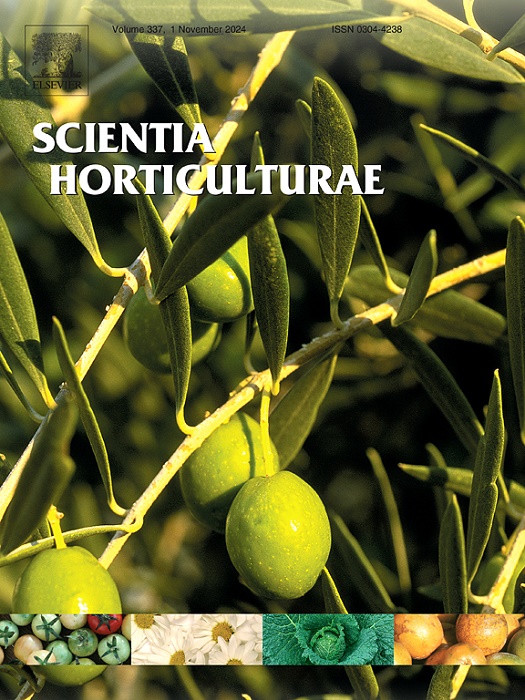壳聚糖基食用涂层中功能添加剂对红薯贮藏过程中理化、生物活性和微生物稳定性的影响
IF 3.9
2区 农林科学
Q1 HORTICULTURE
引用次数: 0
摘要
研究了壳聚糖基食用涂层对红薯采后品质和货架期的影响。将含有壳聚糖/柠檬草精油(LEO)和/或柠檬酸/抗坏血酸的6种EC处理(T2-T7)应用于OFSP,并与未涂覆的样品(T1)一起在受控大气条件下(20°C, 75±5% RH)保存28天。每周分析样品的理化性质(重量减轻、颜色和质地)、总酚含量(Folin测定)、抗氧化能力(TEAC)、生物活性成分(HPLC)和微生物负荷的变化。结果表明,T5(壳聚糖/LEOs)和T7(壳聚糖/LEOs/抗坏血酸/柠檬酸)涂层效果较好。第28天,T5失重最小(5.65%),而T1(未包覆样品)失重最大(13.23%)。OFSP样品中鉴定的主要酚类化合物为4-咖啡酰奎宁酸(4-CQA)和3,5-咖啡酰奎宁酸(3,5- dicqa)。贮藏期结束时,T5的TPC最高,为3.33 mg GAE -1; T7的β-胡萝卜素含量最高(0.72±0.09 mg g-1),与未包膜样品有显著差异(p <;0.05),说明壳聚糖/抗氧化剂在生物活性化合物稳定性中的作用。ECs,尤其是T5和T7,表现出较强的抗菌性能,与对照组相比,它们显著减少了中温细菌数量(p <;0.05)。这项工作为开发生物活性涂层奠定了基础,以保持OFSP的质量和安全性,有助于改善食品安全和营养结果。本文章由计算机程序翻译,如有差异,请以英文原文为准。
Investigation of functional additives in chitosan-based edible coatings and their impact on physicochemical, bioactive, and microbial stability of orange-fleshed sweet potatoes (OFSP) during storage
The efficacy of chitosan-based edible coatings (EC) in enhancing postharvest quality and extending the shelf life of orange-fleshed sweet potatoes (OFSP) is thoroughly investigated in this study. Six EC treatments (T2-T7) containing either chitosan alone/lemongrass essential oil (LEO), and/or citric/ ascorbic acids were applied to OFSP and stored under controlled atmospheric conditions (20 °C, 75 ± 5 % RH) for 28-day period along with an uncoated sample (T1). The samples were analysed weekly for the changes in physicochemical properties (weight loss, colour and texture), total phenolic content (Folin assay), antioxidant capacity (TEAC), bioactive components (HPLC) and microbial load. The results showed that T5 (chitosan/LEOs) and T7 (chitosan/LEOs/ascorbic/citric acid) coatings were particularly effective. T5 exhibited the least weight loss (5.65 %), while T1 (uncoated samples) recorded the greatest weight loss (13.23 %) by day 28. The main phenolic compounds identified in OFSP samples were 4-Caffeoylquinic Acid (4-CQA) and 3,5-Caffeoylquinic Acid (3,5-diCQA). At the end of the storage period, T5 displayed the highest TPC of 3.33 mg GAE g-1 , while T7 recorded the highest β-carotene content (0.72 ± 0.09 mg g⁻¹) and were significantly different from uncoated samples (p < 0.05), suggesting the role of chitosan/ antioxidants in the stability of bioactive compounds. ECs especially T5 and T7 displayed strong antimicrobial properties, which were demonstrated by their significant reduction of mesophilic bacterial counts compared to the control (p < 0.05). This work establishes a basis for developing bioactive coatings for preserving the quality and safety of OFSP, contributing to improved food security and nutritional outcomes.
求助全文
通过发布文献求助,成功后即可免费获取论文全文。
去求助
来源期刊

Scientia Horticulturae
农林科学-园艺
CiteScore
8.60
自引率
4.70%
发文量
796
审稿时长
47 days
期刊介绍:
Scientia Horticulturae is an international journal publishing research related to horticultural crops. Articles in the journal deal with open or protected production of vegetables, fruits, edible fungi and ornamentals under temperate, subtropical and tropical conditions. Papers in related areas (biochemistry, micropropagation, soil science, plant breeding, plant physiology, phytopathology, etc.) are considered, if they contain information of direct significance to horticulture. Papers on the technical aspects of horticulture (engineering, crop processing, storage, transport etc.) are accepted for publication only if they relate directly to the living product. In the case of plantation crops, those yielding a product that may be used fresh (e.g. tropical vegetables, citrus, bananas, and other fruits) will be considered, while those papers describing the processing of the product (e.g. rubber, tobacco, and quinine) will not. The scope of the journal includes all horticultural crops but does not include speciality crops such as, medicinal crops or forestry crops, such as bamboo. Basic molecular studies without any direct application in horticulture will not be considered for this journal.
 求助内容:
求助内容: 应助结果提醒方式:
应助结果提醒方式:


